Daily News
by Gail Helmer
[ Send Us News | Archives ]
IL-2 Sturmovik Patch Update
Ubi Soft has released details regarding the IL-2 Sturmovik Patch. Matt Wagner, Producer, has posted the following comments at the IL-2 Sturmovik site.
iEntertainment Network intends to produce retail versions of its online titles. The titles include WarBirds, Dawn of Aces, and the entire TotalSim series of historically based military simulations. iEntertainment Network has not chosen a publisher for these products but has had discussions with numerous retail distributors worldwide. The publisher will handle the marketing, advertising planning, and spending.
IENT has also launched initiatives that will build the WarBird brand, including an agreement with FurBall.com to form a Player Development Corps. This team of WarBird players will assist the company in developing art and 3D models for WarBirds products. The company has also agreed with another outside company, made up primarily from the player community, to begin work on developing improvements for Dawn of Aces, IENT’s World War I flying game. Players should see improvements in these products shortly, IENT said in a press release.
IENT has also decided to develop the TotalSim series of historical based military simulation games. Based on WarBird technology, the TotalSim series will be complete simulations of W.W.II airpower with WarBirds, W.W.I with Dawn of Aces, Korea with Korean Conflict, and W.W.II land combat with Armored Battle. Each of these products will eventually have its own retail product line and online communities.
New Screens: LOMAC
Ubi Soft has released 8 new screens from Lock On: Modern Air Combat. Lock On: Modern Air Combat combines a broad scope of game play that includes a dynamic battle generator, an immersive combat environment, and in-your-face action. Choose from eight U.S. and Russian jets that range from the tank-killing A-10 Warthog and, ground-pounding Su-25 Frogfoot to air superiority fighters like the F-15C Eagle and Su-27 Flanker. Filled with intense campaigns, realistic flight modeling and flexible game options, Lock On will provide unlimited game play action to both novice and veteran flight sim fans.
New Global Operations Movie
Crave Entertainment has posted two new short movies from Global Operations, featuring the Chechnya and Quebec maps. Global Operations will feature team-based action in 16 different real-world locations, including Peru, Sri Lanka, Mexico, Ireland, and the South China Seas. The game will include more than 30 types of realistic weapons and a variety of equipment, such as body armor, night-vision goggles, binoculars, and medical kits. Release Date: Early 2002. Quebec Movie - Chechnya Movie
New Screens: Team Factor
Czech game developer 7FX has released 6 new screens from their upcoming title "Team Factor". The game will feature three different teams: red, which represents the Russian Spetznaz; blue, a combination of US Army Rangers and German Fallschirmjaegers; and black, which represents the rest of the world. Each team has four basic character types with unique abilities. The game will include more than 40 types of realistic weapons, including pistols, rifles, shotguns, grenades, and machine guns. Release Date: Not Available.
Military News
Davis-Monthan Pilot Killed In A-10 Mishap
DAVIS-MONTHAN AIR FORCE BASE, Ariz. (AFPN) -- An A-10 Thunderbolt II pilot assigned to the 355th Wing here was confirmed dead following a Jan. 17 mishap involving another A-10 on a training mission. The other pilot successfully ejected and is being treated for minor injuries at a local hospital. The mishap occurred at 3 p.m. MST 18.5 miles east of Douglas, Ariz., near the New Mexico and Mexico borders. The pilots' names have not been released.
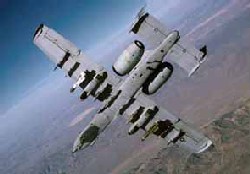
Air Force and Army emergency teams responded to the accident and traveled to the crash site, which is in a remote area. A board of officers, appointed by Air Combat Command headquarters at Langley Air Force Base, Va., will investigate the accident. Since the last 355th Wing accident on May 14, 1998, the 355th Wing has safely flown more than 140,000 hours. Additional information will be made available as it develops.
Irish Air Corps Selects S-92 for SAR Mission
The Republic of Ireland has agreed to begin negotiations for the purchase of three Sikorsky S-92 helicopters to fulfill the Irish Air Corps Search and Rescue (SAR) mission. The award includes an option for two more aircraft for general-purpose military transport.
"Our company founder Igor Sikorsky was inspired by the dream of building a vertical-lift aircraft that could save lives. Sikorsky's new S-92 helicopter is a superb choice to fulfill the SAR mission for the Irish Air Corps," said Sikorsky President Dean C. Borgman. "The S-92 will build upon the Sikorsky tradition of manufacturing robust, high-performance aircraft superbly equipped for saving lives."

Pending final negotiations and the completion of the contract, the award for three aircraft, including support services, is valued at approximately $62 million. This marks the first time that a government customer has selected the S-92.
An international team of companies led by Sikorsky Aircraft Corporation is developing the S-92. Members of the international team are: Embraer of Brazil, Gamesa of Spain, Mitsubishi Heavy Industries of Japan, Jingdezhen Helicopter Group/CATIC of the People's Republic of China, and Aerospace Industrial Development Corporation (AIDC) of Taiwan. Major subcontractors include Hamilton Sundstrand, General Electric, and Rockwell Collins.
T-50 Begins Static Loads Testing
Fort Worth, Texas — The T-50 Golden Eagle advanced jet trainer began static loads testing on schedule on Jan. 2. Testing is being conducted by the team of Korea Aerospace Industries (KAI) and Lockheed Martin Aeronautics at the Korean Aerospace Research Institute in Daejon, Republic of Korea. Test results will be used to certify the flight worthiness of the aircraft and to validate the aircraft structural computer model used in the design of the airframe.
"We are very pleased with the progress of the T-50 development thus far, and we are continuing our program tradition of meeting program milestones," said M.K. Chang, senior vice president of KAI and T-50 program director. "We completed the first aircraft 100 days ahead of schedule last fall and completed the ground vibration testing in December. The static loads testing will verify our design of a very-strong, high-performance aircraft that will meet the demands of both an advanced jet trainer and light combat aircraft derivative."
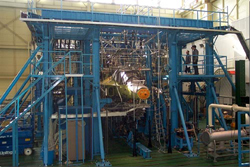
The static test article was completed in October 2001, and extensive instrumentation has been installed and checked out. For the first test case, there are 77 load application locations, 66 deflection measurements and approximately 2,300 strain measurements made on the test article.
The T-50 is designed for load limits of +8gs and –3gs. (1g equals the gross weight of the aircraft, including fuel, stores and pilots.) The first 100 percent limit load test was completed on Jan. 6. Four additional limit load conditions will be tested in January and February in support of dynamic load analysis required prior to first flight. The first flight is scheduled for June of this year.
Forty ultimate load conditions (150 percent of design limit load) are planned. Each load condition test is expected to take approximately two weeks to complete. Static testing is scheduled to complete in August 2003.
A separate ground test article is being built for durability (fatigue) testing and will be completed this spring. Testing is scheduled to begin this summer and will continue through June 2004.
Development testing on the T-50, including the loads testing, is being done with facilities, analytical tools and procedures similar to those used in fighter aircraft development in the United States.
The supersonic T-50 will have the maneuverability, endurance and systems to prepare future pilots to fly current and next-generation fighters like advanced F-16s, the F-22 and the Joint Strike Fighter. These same characteristics give it an excellent capability as a fighter lead-in trainer and light-combat aircraft in many air forces. The lead-in trainer/light-combat version of the Golden Eagle is designated the A-50, and its main differences are the addition of an armament system and fire control radar.
T-50/A-50 advanced technology features include relaxed static stability, digital fly-by-wire flight control, side-stick controller, selectable flight control performance, triple redundant electrical system, on-board oxygen generation system, modern cockpit (head-up display, color multifunction displays, hands-on-stick and throttle, etc.), and (for A-50) integrated armament/fire control avionics.
Lockheed Martin Starts Work On JSF Targeting System
Lockheed Martin Missiles and Fire Control has started work on the multinational Joint Strike Fighter (JSF) electro-optical targeting system, following a recent $171 million subcontract award from BAE SYSTEMS.
Instead of an external pod for detecting and tracking targets, the JSF uses an electro-optical targeting system (EOTS) embedded under the aircraft nose. Lockheed Martin Missiles and Fire Control is teamed with Northrop Grumman Corporation's Electronic Sensors and Systems sector to produce the JSF electro-optical system.
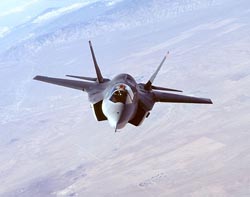
The EOTS is a derivative of Lockheed Martin's Sniper XR, the Advanced Targeting Pod being produced for US Air Force F-15 and F-16 aircraft, and includes many of the same components. Sniper XR is currently undergoing testing for the US Air Force Advanced Targeting Pod program.
The team of Lockheed Martin, Northrop Grumman, and BAE SYSTEMS is producing an initial 22 aircraft in the program's $25 billion System Development and Demonstration phase. The total programme has a projected value of approximately $200 billion and will be a cornerstone of future defence capability for the United States and its allied partners. Plans call for more than 3,000 aircraft over the life of the program.
The targeting system is being developed and manufactured at Lockheed Martin Missiles and Fire Control in Orlando and Ocala in Florida and final assembly of the JSF aircraft will be at Lockheed Martin Aeronautics in Fort Worth, Texas. Over the life of the JSF program, Lockheed Martin's Central Florida businesses expect to gain new work well exceeding $1 billion.
Ultra Electronics To Supply Sonar Equipment For Type 45 Destroyer
Ultra Electronics' Ocean Systems business has been selected by the BAE Systems Prime Contract Office as the preferred supplier for the Medium Frequency Sonar (MFS) for the Type 45 Destroyer.
The initial contract will be for the first six ship sets of equipment and will be worth approximately Ł20m, excluding long term logistic support. Delivery of the equipment for the first ship is planned for 2004 and that of the sixth ship by 2007.
The bow-mounted MFS is intended to provide the Type 45 with the capability to detect submarine and mine threats.
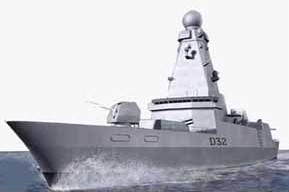
Ultra teamed with the US sonar and combat system specialist EDO Corporation to bid the MFS-7000, a development of the proven sonar system supplied to the Brazilian Navy.
Under the contract, Ultra, as design authority, and EDO will jointly adapt the sonar to meet the Type 45 operational requirement. The EDO technology will be transferred to Ultra in the UK. Ultra will build the sonar and take full responsibility for integrating it onto the Type 45. Ultra will then be ideally placed to provide the Type 45 with long term in-service support.
Apart from EDO, Ultra's other major partner for this contract is W. J. Tod, also of Dorset, who will design and supply the bow dome to protect the sonar sensor assembly.
Commenting on the contract award, Dr Julian Blogh, Chief Executive of Ultra, said: "This contract, which follows the Surface Ship Torpedo Defence award we announced on 14 January, positions Ultra as a strategic supplier of sonar systems to the MOD. Combined, the contracts are potentially worth almost Ł75m, which would provide a further significant boost to Ultra's order book."
US Air Force Selects Langley AFB As First F-22 Home
US Air Force officials have decided to base the first operational wing of F-22 Raptors at Langley Air Force Base in Virginia. The first F-22s are scheduled to arrive at Langley in September 2004 with an initial operating capability beginning in December 2005.
The draft and final statements were prepared to aid in determining whether to bed-down the first operational wing of three squadrons of F-22 aircraft at one of
Five Air Force bases with an existing F-15C mission were considered for the new aircraft: Langley AFB; Eglin AFB and Tyndall AFB in Florida.; Elmendorf AFB in Alaska and Mountain Home AFB in Idaho.
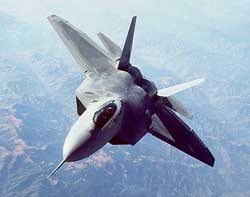
The Air Force identified Langley as the preferred alternative. Each of the alternatives analysed in the final statements included a number of common elements that would occur at the selected base or in its training airspace. The elements include:
The Record of Decision was signed on 15 January by Jimmy Dishner, assistant secretary of the Air Force for environment and installations. The decision is based on the information, analysis, and public comment contained in the Final Environmental Impact Statement for the initial F-22 operational wing bed-down. The statement was developed in accordance with the National Environmental Policy Act and the President's Council on Environmental Quality NEPA Regulations.
[ Send Us News | Archives ]
by Gail Helmer
Friday January 18, 2002
- IL-2 Sturmovik Patch Update
- Warbirds On The Rise and In a Box
- New Screens: LOMAC
- New Global Operations Movie
- New Screens: Team Factor
- Davis-Monthan Pilot Killed In A-10 Mishap
- Irish Air Corps Selects S-92 for SAR Mission
- T-50 Begins Static Loads Testing
- Lockheed Martin Starts Work On JSF Targeting System
- Ultra Electronics To Supply Sonar Equipment For Type 45 Destroyer
- US Air Force Selects Langley AFB As First F-22 Home
IL-2 Sturmovik Patch Update
Ubi Soft has released details regarding the IL-2 Sturmovik Patch. Matt Wagner, Producer, has posted the following comments at the IL-2 Sturmovik site.
Dear IL-2 community,Warbirds On The Rise and In a Box
Oleg, Carl and I are happy to announce that the second patch for IL-2 is currently in test and will be available for download soon. We understand that some of you will want the patch NOW, but we first must ensure quality; have patience please. This patch is designed to address some of IL-2’s more pressing issues, but it is by no means the last patch. Further patches will be forthcoming.
Contents of the upcoming patch include:
Bug Fixes
1. Solved centering force problems with some force-feedback joysticks.
2. Fixed stutter issue when playing mission files with large amounts of ground activity.
3. Fixed the issue with custom skins appearing incorrectly when playing dogfight missions.
4. Corrected mistakes in aircraft machine guns rate of fire.
Updates
1. Native characters in saved filenames can now be used.
2. Implemented support for the latest version of the UBI Game Service.
3. Modified aircraft AI-controlled turret aiming routines to be less accurate.
4. Added kill messages for multiplayer sessions.
Regarding the stutter issue, this patch should greatly alleviate the problem. However, please be aware that if you attempt to run IL-2 at greater detail levels than your hardware is capable of, you will have performance degradation. In such a case, we highly recommend lowering your detail levels and sound quality.
During a phone conference between Oleg, Carl, and myself, we discussed several exciting, new projects for IL-2. While we are not at a point to release details, I firmly believe that the IL-2 faithful will be very, very pleased. Additionally, we discussed the future of third party support and dedicated servers; all of which sounds very promising. We hope to have more information to share with you soon.
We’re all working very hard to make IL-2 an even greater product and the future is looking very bright. We realize that you would like even more information about what is in store, but until we have poured the concrete we must hold on to some information, in order to avoid later misunderstandings. Please have patience.
After a well-earned vacation, Oleg will be returning soon. I’m sure you’ll give him a hearty welcome back.
Thank you for your support,
Matt Wagner
Producer
Ubi Soft Entertainment
iEntertainment Network intends to produce retail versions of its online titles. The titles include WarBirds, Dawn of Aces, and the entire TotalSim series of historically based military simulations. iEntertainment Network has not chosen a publisher for these products but has had discussions with numerous retail distributors worldwide. The publisher will handle the marketing, advertising planning, and spending.
IENT has also launched initiatives that will build the WarBird brand, including an agreement with FurBall.com to form a Player Development Corps. This team of WarBird players will assist the company in developing art and 3D models for WarBirds products. The company has also agreed with another outside company, made up primarily from the player community, to begin work on developing improvements for Dawn of Aces, IENT’s World War I flying game. Players should see improvements in these products shortly, IENT said in a press release.
IENT has also decided to develop the TotalSim series of historical based military simulation games. Based on WarBird technology, the TotalSim series will be complete simulations of W.W.II airpower with WarBirds, W.W.I with Dawn of Aces, Korea with Korean Conflict, and W.W.II land combat with Armored Battle. Each of these products will eventually have its own retail product line and online communities.
New Screens: LOMAC
Ubi Soft has released 8 new screens from Lock On: Modern Air Combat. Lock On: Modern Air Combat combines a broad scope of game play that includes a dynamic battle generator, an immersive combat environment, and in-your-face action. Choose from eight U.S. and Russian jets that range from the tank-killing A-10 Warthog and, ground-pounding Su-25 Frogfoot to air superiority fighters like the F-15C Eagle and Su-27 Flanker. Filled with intense campaigns, realistic flight modeling and flexible game options, Lock On will provide unlimited game play action to both novice and veteran flight sim fans.
New Global Operations Movie
Crave Entertainment has posted two new short movies from Global Operations, featuring the Chechnya and Quebec maps. Global Operations will feature team-based action in 16 different real-world locations, including Peru, Sri Lanka, Mexico, Ireland, and the South China Seas. The game will include more than 30 types of realistic weapons and a variety of equipment, such as body armor, night-vision goggles, binoculars, and medical kits. Release Date: Early 2002. Quebec Movie - Chechnya Movie
New Screens: Team Factor
Czech game developer 7FX has released 6 new screens from their upcoming title "Team Factor". The game will feature three different teams: red, which represents the Russian Spetznaz; blue, a combination of US Army Rangers and German Fallschirmjaegers; and black, which represents the rest of the world. Each team has four basic character types with unique abilities. The game will include more than 40 types of realistic weapons, including pistols, rifles, shotguns, grenades, and machine guns. Release Date: Not Available.
Military News
Davis-Monthan Pilot Killed In A-10 Mishap
DAVIS-MONTHAN AIR FORCE BASE, Ariz. (AFPN) -- An A-10 Thunderbolt II pilot assigned to the 355th Wing here was confirmed dead following a Jan. 17 mishap involving another A-10 on a training mission. The other pilot successfully ejected and is being treated for minor injuries at a local hospital. The mishap occurred at 3 p.m. MST 18.5 miles east of Douglas, Ariz., near the New Mexico and Mexico borders. The pilots' names have not been released.

Air Force and Army emergency teams responded to the accident and traveled to the crash site, which is in a remote area. A board of officers, appointed by Air Combat Command headquarters at Langley Air Force Base, Va., will investigate the accident. Since the last 355th Wing accident on May 14, 1998, the 355th Wing has safely flown more than 140,000 hours. Additional information will be made available as it develops.
Irish Air Corps Selects S-92 for SAR Mission
The Republic of Ireland has agreed to begin negotiations for the purchase of three Sikorsky S-92 helicopters to fulfill the Irish Air Corps Search and Rescue (SAR) mission. The award includes an option for two more aircraft for general-purpose military transport.
"Our company founder Igor Sikorsky was inspired by the dream of building a vertical-lift aircraft that could save lives. Sikorsky's new S-92 helicopter is a superb choice to fulfill the SAR mission for the Irish Air Corps," said Sikorsky President Dean C. Borgman. "The S-92 will build upon the Sikorsky tradition of manufacturing robust, high-performance aircraft superbly equipped for saving lives."

Pending final negotiations and the completion of the contract, the award for three aircraft, including support services, is valued at approximately $62 million. This marks the first time that a government customer has selected the S-92.
An international team of companies led by Sikorsky Aircraft Corporation is developing the S-92. Members of the international team are: Embraer of Brazil, Gamesa of Spain, Mitsubishi Heavy Industries of Japan, Jingdezhen Helicopter Group/CATIC of the People's Republic of China, and Aerospace Industrial Development Corporation (AIDC) of Taiwan. Major subcontractors include Hamilton Sundstrand, General Electric, and Rockwell Collins.
T-50 Begins Static Loads Testing
Fort Worth, Texas — The T-50 Golden Eagle advanced jet trainer began static loads testing on schedule on Jan. 2. Testing is being conducted by the team of Korea Aerospace Industries (KAI) and Lockheed Martin Aeronautics at the Korean Aerospace Research Institute in Daejon, Republic of Korea. Test results will be used to certify the flight worthiness of the aircraft and to validate the aircraft structural computer model used in the design of the airframe.
"We are very pleased with the progress of the T-50 development thus far, and we are continuing our program tradition of meeting program milestones," said M.K. Chang, senior vice president of KAI and T-50 program director. "We completed the first aircraft 100 days ahead of schedule last fall and completed the ground vibration testing in December. The static loads testing will verify our design of a very-strong, high-performance aircraft that will meet the demands of both an advanced jet trainer and light combat aircraft derivative."

The static test article was completed in October 2001, and extensive instrumentation has been installed and checked out. For the first test case, there are 77 load application locations, 66 deflection measurements and approximately 2,300 strain measurements made on the test article.
The T-50 is designed for load limits of +8gs and –3gs. (1g equals the gross weight of the aircraft, including fuel, stores and pilots.) The first 100 percent limit load test was completed on Jan. 6. Four additional limit load conditions will be tested in January and February in support of dynamic load analysis required prior to first flight. The first flight is scheduled for June of this year.
Forty ultimate load conditions (150 percent of design limit load) are planned. Each load condition test is expected to take approximately two weeks to complete. Static testing is scheduled to complete in August 2003.
A separate ground test article is being built for durability (fatigue) testing and will be completed this spring. Testing is scheduled to begin this summer and will continue through June 2004.
Development testing on the T-50, including the loads testing, is being done with facilities, analytical tools and procedures similar to those used in fighter aircraft development in the United States.
The supersonic T-50 will have the maneuverability, endurance and systems to prepare future pilots to fly current and next-generation fighters like advanced F-16s, the F-22 and the Joint Strike Fighter. These same characteristics give it an excellent capability as a fighter lead-in trainer and light-combat aircraft in many air forces. The lead-in trainer/light-combat version of the Golden Eagle is designated the A-50, and its main differences are the addition of an armament system and fire control radar.
T-50/A-50 advanced technology features include relaxed static stability, digital fly-by-wire flight control, side-stick controller, selectable flight control performance, triple redundant electrical system, on-board oxygen generation system, modern cockpit (head-up display, color multifunction displays, hands-on-stick and throttle, etc.), and (for A-50) integrated armament/fire control avionics.
Lockheed Martin Starts Work On JSF Targeting System
Lockheed Martin Missiles and Fire Control has started work on the multinational Joint Strike Fighter (JSF) electro-optical targeting system, following a recent $171 million subcontract award from BAE SYSTEMS.
Instead of an external pod for detecting and tracking targets, the JSF uses an electro-optical targeting system (EOTS) embedded under the aircraft nose. Lockheed Martin Missiles and Fire Control is teamed with Northrop Grumman Corporation's Electronic Sensors and Systems sector to produce the JSF electro-optical system.

The EOTS is a derivative of Lockheed Martin's Sniper XR, the Advanced Targeting Pod being produced for US Air Force F-15 and F-16 aircraft, and includes many of the same components. Sniper XR is currently undergoing testing for the US Air Force Advanced Targeting Pod program.
The team of Lockheed Martin, Northrop Grumman, and BAE SYSTEMS is producing an initial 22 aircraft in the program's $25 billion System Development and Demonstration phase. The total programme has a projected value of approximately $200 billion and will be a cornerstone of future defence capability for the United States and its allied partners. Plans call for more than 3,000 aircraft over the life of the program.
The targeting system is being developed and manufactured at Lockheed Martin Missiles and Fire Control in Orlando and Ocala in Florida and final assembly of the JSF aircraft will be at Lockheed Martin Aeronautics in Fort Worth, Texas. Over the life of the JSF program, Lockheed Martin's Central Florida businesses expect to gain new work well exceeding $1 billion.
Ultra Electronics To Supply Sonar Equipment For Type 45 Destroyer
Ultra Electronics' Ocean Systems business has been selected by the BAE Systems Prime Contract Office as the preferred supplier for the Medium Frequency Sonar (MFS) for the Type 45 Destroyer.
The initial contract will be for the first six ship sets of equipment and will be worth approximately Ł20m, excluding long term logistic support. Delivery of the equipment for the first ship is planned for 2004 and that of the sixth ship by 2007.
The bow-mounted MFS is intended to provide the Type 45 with the capability to detect submarine and mine threats.

Ultra teamed with the US sonar and combat system specialist EDO Corporation to bid the MFS-7000, a development of the proven sonar system supplied to the Brazilian Navy.
Under the contract, Ultra, as design authority, and EDO will jointly adapt the sonar to meet the Type 45 operational requirement. The EDO technology will be transferred to Ultra in the UK. Ultra will build the sonar and take full responsibility for integrating it onto the Type 45. Ultra will then be ideally placed to provide the Type 45 with long term in-service support.
Apart from EDO, Ultra's other major partner for this contract is W. J. Tod, also of Dorset, who will design and supply the bow dome to protect the sonar sensor assembly.
Commenting on the contract award, Dr Julian Blogh, Chief Executive of Ultra, said: "This contract, which follows the Surface Ship Torpedo Defence award we announced on 14 January, positions Ultra as a strategic supplier of sonar systems to the MOD. Combined, the contracts are potentially worth almost Ł75m, which would provide a further significant boost to Ultra's order book."
US Air Force Selects Langley AFB As First F-22 Home
US Air Force officials have decided to base the first operational wing of F-22 Raptors at Langley Air Force Base in Virginia. The first F-22s are scheduled to arrive at Langley in September 2004 with an initial operating capability beginning in December 2005.
The draft and final statements were prepared to aid in determining whether to bed-down the first operational wing of three squadrons of F-22 aircraft at one of
Five Air Force bases with an existing F-15C mission were considered for the new aircraft: Langley AFB; Eglin AFB and Tyndall AFB in Florida.; Elmendorf AFB in Alaska and Mountain Home AFB in Idaho.

The Air Force identified Langley as the preferred alternative. Each of the alternatives analysed in the final statements included a number of common elements that would occur at the selected base or in its training airspace. The elements include:
- Establishing three squadrons with a total of 72 primary aircraft and six backup aircraft, and replacing existing F-15 Eagle aircraft at the base over a period of about five years, with construction beginning in 2002;
- Conducting flying operations at the base for training and operational deployment;
- Constructing base facilities and infrastructure necessary to support the initial F-22 operational wing;
- Implementing personnel changes at the base to conform to the F-22 wing's requirements;
- Conducting F-22 training activities in existing training airspace, emphasising air-to-air combat and supersonic flight (where authorised), including military operations areas;
- Air traffic control assigned airspaces and warning areas;
- Employing defensive countermeasures, such as chaff and flares, in airspace authorised for such use; and
The Record of Decision was signed on 15 January by Jimmy Dishner, assistant secretary of the Air Force for environment and installations. The decision is based on the information, analysis, and public comment contained in the Final Environmental Impact Statement for the initial F-22 operational wing bed-down. The statement was developed in accordance with the National Environmental Policy Act and the President's Council on Environmental Quality NEPA Regulations.
